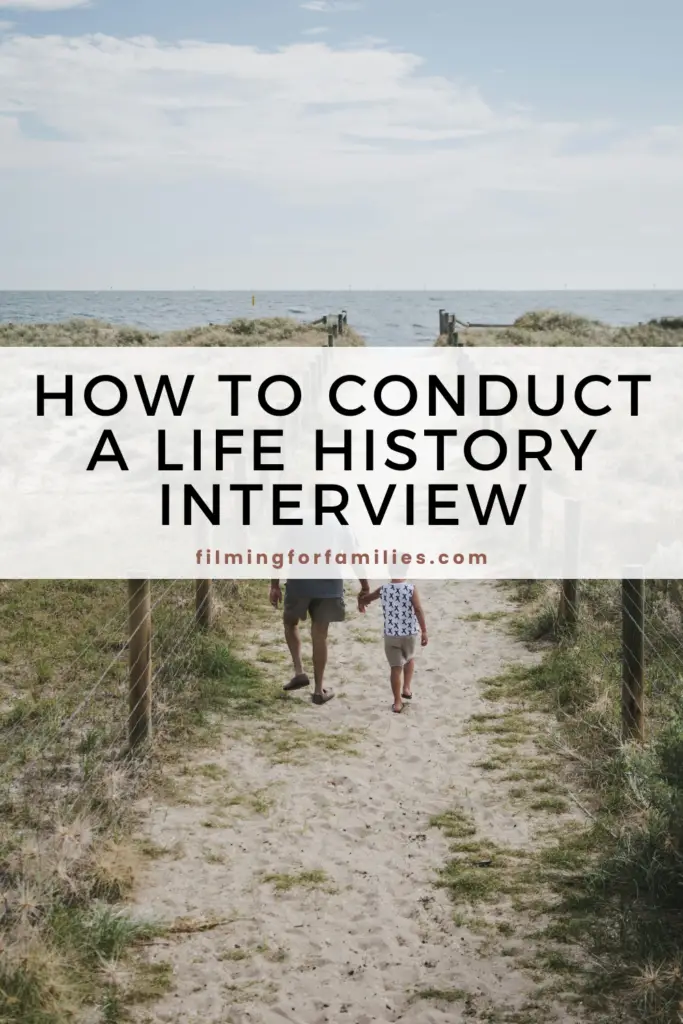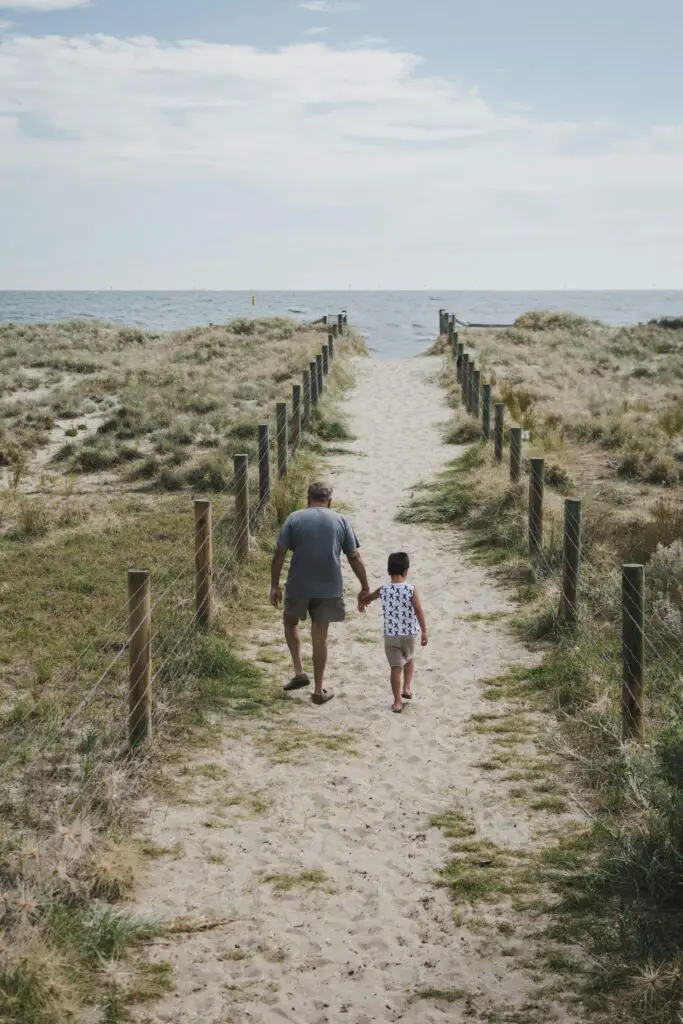Staring at the camera, heart pounding, palms sweaty. Yep, that’s the feeling of wanting to capture your family’s legacy perfectly, but having no idea where to start. Sound familiar?
You’re probably thinking, “I can’t mess this up.
This is for the grandkids!” And you’re right, it is important. But who said “important” has to mean “impossible”?
Let’s ditch the pressure cooker and turn this interview into something you (and your family) will actually enjoy.
Let’s get started to make some life history.
Pre-Interview Preparation
Goal Setting
Before you hit record, what’s the heart of this interview? Are you preserving Grandma’s stories for future generations, or documenting Grandpa’s journey as an immigrant? Nailing down your purpose will guide your entire interview.
Think of it as your interview’s North Star – it’ll keep you on track and ensure you capture the stories that truly matter. And who’s your audience? Knowing this helps tailor your questions and create a more impactful interview.
Remember, we’re not aiming for Hollywood here. It’s about genuine moments and heartfelt stories. So, set realistic expectations. Some interviews flow smoothly, others need coaxing. That’s okay! The goal is meaningful, not perfect.
Choosing Your Interviewee(s)
Now, who’s going to spill the beans? This is where you pick the family MVPs – the ones with the most captivating tales or unique perspectives. Don’t be afraid to mix it up! Maybe Grandma’s got the family gossip on lock, while your teenage niece has a fresh take on growing up in the digital age.
Consider different generations to get a panoramic view of your family history. Your great-uncle might remember stories your grandparents have long forgotten. And hey, who says you have to stick to one interviewee? If there’s a whole crew of captivating characters, why not interview them all? The more, the merrier, right?
But let’s be real, scheduling a family reunion around your interview might be a bit much. So, start small and be flexible. You might begin with one person and realize they’ve opened the door to a whole new branch of the family tree you never knew existed.
Logistics:
Okay, let’s schedule this. No boardrooms here, just comfort. Where does your interviewee feel most at home? Their living room? A favorite coffee shop? A sunny spot in the garden?
Be considerate with timing.
Avoid rushing them after work or during their favorite TV show. Find a time that allows for a relaxed conversation.
Tech-wise, ensure clear quality. If using video, charge your camera and check the lighting. For audio, a good microphone is key. No need for fancy gear, just clear sound.
Remember, this is about connection, not a press conference. Create a warm, inviting atmosphere. The stories will flow from there.
Developing Questions:
Time to channel your inner journalist. We’re crafting questions that’ll unlock a treasure trove of stories. But forget those boring “yes” or “no” questions. We want open-ended gems that spark conversation and invite your interviewee to share their heart out.
Think about the topics you’re most curious about.
Maybe you’re dying to know about your grandma’s childhood pranks, or your dad’s first job. Whatever it is, jot down some questions that’ll get them reminiscing. And hey, don’t be afraid to get specific. Instead of asking, “What was your childhood like?” try something like, “What was your favorite game to play as a kid?” The more detailed your questions, the more vivid their answers will be.
Now, here’s the secret sauce: be prepared to go off-script.
Your list of questions is a roadmap, not a rulebook. If your interviewee starts sharing a hilarious story about their pet turtle, don’t cut them off just because it wasn’t on your list. Let the conversation flow naturally, and be ready to follow their lead.
And one last tip: don’t be afraid to ask the tough questions.
Life isn’t all sunshine and rainbows, and sometimes the most powerful stories come from moments of hardship or challenge. Just approach these topics with sensitivity and respect.
Section 2: Conducting the Interview
Setting the Tone:
Lights, camera, action…
But hold on, before you jump into the heavy stuff, let’s set the mood. This isn’t an interrogation; it’s a heart-to-heart. Think cozy vibes, not courtroom drama. Crack a joke, share a memory, or simply ask how their day’s been. A warm, inviting atmosphere is your secret weapon to unlocking those hidden gems of stories.
Remember, this is about connection.
Your genuine interest and enthusiasm will put your interviewee at ease and encourage them to open up. So, ditch the poker face and let your curiosity shine through. Smile, nod, and laugh along with their stories. Active listening is key here. Make eye contact, lean in, and show them you’re hanging on to their every word.
And hey, don’t be afraid to get a little personal.
Share a relevant anecdote of your own to break the ice and show your vulnerability. This can create a deeper connection and inspire them to share more openly.
Think of it as a dance, not a monologue. It’s a give-and-take, a conversation where both of you feel comfortable and heard. So, take a deep breath, relax those shoulders, and let the magic unfold.
Asking Questions:
Alright, you’ve set the scene and everyone’s feeling relaxed. Now comes the fun part: asking those burning questions! But hold your horses, this isn’t a rapid-fire round. Take a deep breath and remember, you’re not just collecting data, you’re weaving a tapestry of stories.
Start by easing into it.
Begin with those lighthearted questions you prepared – the ones that bring a smile to their face or spark a fond memory. Maybe it’s about their first pet, or a funny childhood nickname. These easy questions build a sense of trust and encourage them to share more.
As the conversation warms up, feel free to stray from your script. Think of those prepared questions as stepping stones, not a rigid path. If your interviewee starts meandering down memory lane, follow their lead! Some of the most precious stories are found in those spontaneous detours.
Don’t be afraid to ask those “tell me more” questions.
If something piques your interest, dig deeper. Ask for details, descriptions, and emotions. “What did it feel like when you first held your child?” “What were the challenges you faced starting your own business?” These questions take the story beyond the surface and reveal the heart beneath.
Pay attention to their tone of voice, their facial expressions, and their body language. These non-verbal cues can reveal just as much as their words, if not more.
Navigating Sensitive Topics:
Let’s face it, life isn’t all sunshine and rainbows.
Sooner or later, you might stumble upon a sensitive topic. It could be a painful memory, a past heartbreak, or even a family feud. But don’t panic! This is where your empathy and tact come into play.
Remember, you’re not just an interviewer, you’re a confidant. Approach these topics with gentle curiosity and respect. Let your interviewee know that it’s okay to share as much or as little as they feel comfortable with. There’s no pressure, no judgment – just a safe space to share their story.
If emotions start to rise, don’t try to brush them aside.
Acknowledge their feelings and offer a comforting word. “That must have been really tough,” or “I can’t imagine how difficult that was.” A simple acknowledgment can go a long way in making them feel heard and understood.
And if they choose not to delve into a particular topic, respect their boundaries. Gently steer the conversation in a different direction. Remember, the goal is to create a positive and empowering experience.
Now, here’s a pro tip: before the interview, have a chat with your interviewee about any potential sensitive topics. Let them know you’re open to discussing them, but only if they feel comfortable. This gives them a heads-up and allows them to prepare mentally.
Technical Tips:
Double-check your tech. Ensure your video camera is charged and the lens is clean for clear footage. If using a microphone, test it for clear audio. Adjust settings or switch microphones if needed.
Lighting matters too. Natural light is best, but if indoors, ensure good lighting and avoid harsh shadows. You want your interviewee to look their best.
Take breaks.
Even the best storytellers need a breather. If they get tired or lose focus, suggest a quick break to stretch or get coffee.
Experiment with different camera angles and shots for visual interest (if using video). Mix close-ups and wide shots, but remember, the focus is on the person, not your camera skills.
Transcribing and Editing:
Lights, camera… transcript.
Now that you’ve got your interview in the can, it’s time to transform those spoken words into a written treasure. This might sound tedious, but trust me, it’s worth it. A transcript not only creates a permanent record of your interview, but it also makes it easier to search for specific moments and quotes later on.
Now, you could transcribe the interview yourself (cue the endless hours of rewinding and fast-forwarding), or you could enlist some help. There are plenty of transcription services available online that can do the heavy lifting for you. It’s a small investment for a huge payoff.
Once you’ve got your transcript, it’s time to channel your inner editor. Don’t worry, we’re not talking about cutting entire scenes or adding dramatic music. We’re simply polishing the rough edges to make the story shine.
Fix any typos or grammatical errors, and remove any filler words or repetitive phrases. You want the transcript to read smoothly and naturally.
Sharing and Preserving:
Finally. You’ve captured a treasure trove of family stories.
Now it’s time to share the wealth and ensure those memories live on for generations to come. Think of yourself as a curator of your family’s history, preserving these precious moments for future generations.
One option is to create a family video or audio recording. You can simply edit together the best bits of your interview, or get creative and add music, photos, and other personal touches. Imagine the joy on your family’s faces as they watch themselves on the big screen, reliving those cherished moments.
But don’t stop there.
Share the interview with your extended family and friends. You can send them a link to the video, burn copies of the audio recording, or even host a viewing party. It’s a wonderful way to connect with loved ones and spark conversations about your shared history.
And of course, don’t forget to archive the original recording and transcript.
This is your master copy, the one you’ll want to keep safe and sound for future generations. Store it in a secure location, like a fireproof safe or a cloud storage service. You can even create multiple copies and distribute them to different family members, just in case.
And if you’re looking for more tips and tricks on family videography, don’t forget to subscribe to our blog for upcoming resources and guides. To learn more about video creation, check out our Beginners Guide to Family Videography.




